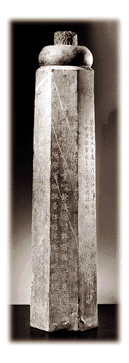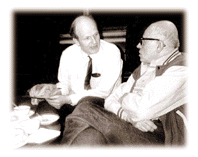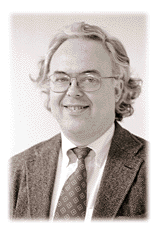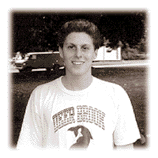Notebook - April 21, 1999
A broader look at religion
New center to promote scholarship on a neglected subject
We believe that religion is the most understudied social phenomenon of
the 20th century," says Robert J. Wuthnow, a professor of social sciences
and of sociology. "Perhaps in part because of church-state concerns,
the study of religion has been excluded from the agendas at research universities.
Yet religion is a social and cultural practice that wields extraordinary
influence in world events."
Wuthnow is founding director of Princeton's new Center for the Study
of Religion, which will nurture the understanding of religion within disciplines
other than religious studies -- such as history, literature, sociology,
and anthropology -- and facilitate interaction among scholars across those
various disciplines.
Princeton marked the establishment of the center on March 29 with an
inaugural lecture. Next fall, the new center will be housed in several offices
in 1879 Hall, but it will likely move to another location when the Frist
Campus Center is completed.
Wuthnow said that over the past two decades, Princeton has emerged as
one of only a few universities in which teaching and research are being
conducted on the diverse manifestations of religion through the lenses of
varied disciplines. In addition to the Department of Religion, more than
50 faculty members in a dozen other departments and programs contribute
regularly to the understanding of religion through their various scholarly
perspectives.
"Many faculty members are attracted to Princeton by the availability
of the Mesoamerican Archive, the Index of Christian Art, and other scholarly
resources important to the interdisciplinary study of religion," said
Wuthnow, "but they find themselves wanting opportunities to interact
with one another....We believe the new center will fill this need."
In general, he said, the center "will provide a place for doing
serious scholarly studies that acknowledge the diversity of religious expressions
and that may be relevant to immediate questions of public policy."
The new center will subsume the Center for the Study of American Religion,
which the university established in 1991, permitting work to continue on
religion in the United States while also promoting scholarship on other
religions and societies.
The Center for the Study of Religion will sponsor an interdisciplinary
graduate seminar, the development of new undergraduate courses, and thematic
research projects.
An example of a research project is one on religion and the senses, sponsored
by the Center for the Study of American Religion in 1998-99 and developed
by Associate Professor of Religion Leigh Eric Schmidt *87.
Schmidt is offering a graduate seminar on this topic and has organized
a conference that will take place May 21-23. An international group of sociologists,
anthropologists, historians, and religious experts will examine "how
the senses are used to imagine the body and soul -- and God -- in the Western
religious tradition," Schmidt said. He is also completing a book, Hearing
Things: The Mystic's Ear and the Voices of Reason, based on the research
that framed the graduate seminar and the conference.
Examples of possible thematic projects for the future are religion in
African-American literature, Islamic revivalism, the spirituality of 20th-century
European artists, and the role of faith-based communities in responding
to the needs of at-risk youth in inner cities.
-- Justin Harmon '78
Chinese calligraphy, ceramics on
display at the Art Museum
 A19th-century stone pillar inscribed with figures of Buddha and magic
spells and the work of calligrapher Li Jui-ch'ing, pictured above in a close-up
of a hanging scroll from 1916, are among the works of art in a major exhibition
of one of the most comprehensive collections of Chinese calligraphy ever
assembled outside Asia. "The Embodied Image: Chinese Calligraphy from
the John B. Elliott ['51] Collection" will be on view at the Art Museum
through June 27. It includes works from the 4th through the 20th centuries
by calligraphers such as Wang Hsi-chih, Huang T'ing-chien, and Mi Fu, as
well as those by ancient scribes and a collection of letters by poets, scholars,
monks, and scholar-officials. Many of these works will be on view for the
first time. The exhibition will travel to the Seattle Museum of Art and
the Metropolitan Museum of Art, in New York City.
A19th-century stone pillar inscribed with figures of Buddha and magic
spells and the work of calligrapher Li Jui-ch'ing, pictured above in a close-up
of a hanging scroll from 1916, are among the works of art in a major exhibition
of one of the most comprehensive collections of Chinese calligraphy ever
assembled outside Asia. "The Embodied Image: Chinese Calligraphy from
the John B. Elliott ['51] Collection" will be on view at the Art Museum
through June 27. It includes works from the 4th through the 20th centuries
by calligraphers such as Wang Hsi-chih, Huang T'ing-chien, and Mi Fu, as
well as those by ancient scribes and a collection of letters by poets, scholars,
monks, and scholar-officials. Many of these works will be on view for the
first time. The exhibition will travel to the Seattle Museum of Art and
the Metropolitan Museum of Art, in New York City.
Also on exhibit are more than 40 works of Chinese ceramics from the collection
of Nelson A. Chang '74, who has lent the pieces in honor of his 25th reunion.
"From Ritual Simplicity to Imperial Splendor," on view through
September 26, includes works from the early third millennium b.c. to the
late 18th century.
Analyst works to avoid nuclear
disasters and near misses
That was one of the things about the end of the war. Absolutely
anybody who wanted a weapon could have one. They were lying all around.
--Kurt Vonnegut, Slaughterhouse Five
 Disarmament policy analyst Frank N. von Hippel finds Vonnegut's
observation apt in the aftermath of the Cold War. In the economic rubble
of Russia, the scientists and technicians who built the Soviet nuclear armory
are as poorly and infrequently paid as factory hands, despite the temptation
to peddle their skills and pilfered plutonium to rogue states and aspiring
nuclear powers.
Disarmament policy analyst Frank N. von Hippel finds Vonnegut's
observation apt in the aftermath of the Cold War. In the economic rubble
of Russia, the scientists and technicians who built the Soviet nuclear armory
are as poorly and infrequently paid as factory hands, despite the temptation
to peddle their skills and pilfered plutonium to rogue states and aspiring
nuclear powers.
"There have been two miracles in the last half of this century,"
observes von Hippel. "First, we haven't had a nuclear war. The second
miracle, the one we're in the middle of now, is that there has not been
a hemorrhage of nuclear material and talent during the collapse in Russia."
Over the past 25 years, von Hippel's work as an analyst has focused on
reducing the world's reliance on miracles. A professor of public and international
affairs, he codirects the Research Program on Nuclear Policy Alternatives
with senior research policy scientist Harold A. Feiveson *72 at the Center
for Energy and Environmental Studies (CEES). "Here, for the first time,
we're laying out the technical basis for nuclear arms control," von
Hippel says.
Avoiding nuclear disaster, he believes, requires practical solutions
to specific problems. Among current projects of the research program are
efforts toward taking U.S. and Russian nuclear missiles off "launch
on warning" postures, helping Russia's nuclear-weapons complex convert
to civilian nuclear missions, a verified global ban on the production of
fissile material for nuclear weapons, and verified elimination of U.S. and
Russian excess nuclear warheads.
Any sense that the risk of nuclear war ended with the demise of the Soviet
Union is exaggerated, von Hippel warns. Nuclear arsenals built during the
long ideological struggle between the superpowers remain ready for use a
decade after the Soviet Union dissolved. The United States and Russia each
has 2,000 warheads ready to launch on 15 minutes' notice, a posture known
as "launch on warning."
While the threat of a deliberate attack has faded, the possibility persists
that a technical or human error could trigger an exchange of missiles, von
Hippel points out. He cites an incident in January 1995, when a research
rocket launched from the Norwegian island of Andoya was mistaken for a submarine-launched
nuclear missile by Russian air-defense forces. The "nuclear suitcase"
held by an aide to Russian President Boris Yeltsin was activated, and a
decision to launch a counterattack was minutes away before the blip on Russian
radar screens was judged harmless.
To prevent such near misses, von Hippel and Feiveson are working with
Bruce Blair of the Brookings Institution in Washington, D.C., on proposals
to remove the trip wire from both U.S. and Russian missiles without making
either side vulnerable to a surprise attack. These proposals would establish
a situation "where it would take hours to launch a missile instead
of minutes," von Hippel notes. "That would be an improvement."
Von Hippel believes that helping Russia's nuclear cities convert to civilian
activities is crucial to strengthening the security of the Russian nuclear
stockpile. The Nuclear Cities Initiative, which creates employment for technicians
and scientists, was proposed in 1997 and is federally funded this year at
$30 million. As "key collaborators" in this effort, von Hippel
cites senior visiting fellow Kenneth N. Luongo, research staff member Oleg
A. Bukharin '90, Matthew Bunn of Harvard's Kennedy School, and Jill K. Cetina
*94, who works in the U.S. Treasury Department.
A verified global ban on the production of fissile material for nuclear
weapons and verified elimination of U.S. and Russian excess nuclear warheads
are projects von Hippel and his colleagues have worked on for many years.
Both proposals are actively on the table now. Multilateral negotiations
on a fissile material ban "are on the negotiating agenda now at the
U.N. Conference on Disarmament in Geneva," von Hippel says, and elimination
of excess nuclear warheads is "on the U.S.-Russian negotiating agenda."
Analysts' Role
For a decade after earning his Ph.D. in theoretical physics at Oxford
University in 1962, von Hippel followed a conventional path of teaching
and research. "I was probably among the top 10 percent of theoretical
elementary particle physicists," he says, "but all the action
was in the top 1 percent. I didn't feel I was making enough of a contribution."
In 1969, while finishing up a three-year stint as an assistant professor
at Stanford, he made his first foray into what he calls "public interest
science." He agreed to serve as faculty adviser to a student group
trying to understand why scientific advice was not having more impact on
such decisions as whether the United States should build an antiballistic
missile defense.
Von Hippel came to Princeton in 1974 as a senior research physicist at
CEES, where, in the late 1970s, he and his colleagues turned their attention
to the nuclear-proliferation dangers of plutonium-breeder reactors. These
reactors were being trumpeted as the energy source of the future because
of the plutonium they yielded as a by-product of generating electricity.
The CEES research group calculated that a global "plutonium economy"
would annually yield enough plutonium to build a virtually unlimited number
of nuclear bombs.
When President Ronald Reagan took office, with his talk of the Soviet
"evil empire," von Hippel turned his full attention to the nuclear
arms race. He sought ways to make the disarmament envisioned by activists
seem feasible to a national-security establishment that viewed disarmament
proposals as either impossible or reckless.
The analyst's role, he explained, is to devise the technical means that
will convince military leaders that their national security will be enhanced,
not reduced, by what diplomats call "transparent and irreversible reductions"
in nuclear weapons. Von Hippel has been asked to facilitate the background
discussions that will launch U.S.-Russian negotiations in this area.
Von Hippel's only experience working inside government was a brief stint
as a science adviser in the Clinton administration. He was frustrated by
the avalanche of faxes, e-mail, and phone calls, and by the sense of skipping
from crisis to crisis.
"When you're inside the government you don't have time to think,"
he says. "People like me, who are on the outside, set the agenda. We
can't make the decisions, but we can give the decision-makers ideas."
-- Peter Page
This article appeared in the March 1 issue of the Princeton Weekly
Bulletin.
Music professor sues band for hearing
loss
 Professor of Music Peter Jeffery *80 claims the rock group Smashing
Pumpkins wound up smashing his hearing at a concert two years ago, and he's
suing the band for damages.
Professor of Music Peter Jeffery *80 claims the rock group Smashing
Pumpkins wound up smashing his hearing at a concert two years ago, and he's
suing the band for damages.
A Gregorian chant expert, Jeffery wasn't prepared for the onslaught of
a 20th-century rock concert when he took his son to see the band in New
Haven, Connecticut, on January 25, 1997. Jeffery, who had never been to
a rock concert before, claims he suffered a 4-percent permanent hearing
loss in his left ear and constant ringing in both ears, even though he wore
earplugs to the show. His suit against the band, Virgin Records, the New
Haven Coliseum, the city of New Haven, and earplug manufacturer Siebe North
Inc. says the music exceeded safe decibel levels.
Jeffery referred calls to his lawyer, Anthony Wallace of New Haven, who
predicted a jury would award more than $1 million if the case goes to trial.
"You can't put a figure on this," Wallace said. Jeffrey needs
precise hearing for his work and fears the hearing damage may affect that.
"I have this really annoying hissing noise that I can't turn off,"
Jeffery told The Daily Princetonian. "I've lost a lot of the
enjoyment I used to have."
But shouldn't Jeffery have known a rock concert would be loud? "He'd
never been to a rock concert before," said Wallace. "He thought
it would be loud, or a little louder than his son's stereo."
After the Associated Press first reported the suit in March, Jeffery
received e-mails from Pumpkins fans calling him a "jerk" and "stupid."
But since then, he's also received supportive e-mails, Wallace said.
Smashing Pumpkins' label, Virgin Records, did not return a telephone
call seeking comment.
-- Frederic J. Frommer
Freshman dies
 Matthew Weiner '02, a Wilson College resident from Medford, New Jersey,
died on March 22 after collapsing from cardiac arrest during a game of pickup
basketball on a court near Spelman Hall. He was 19. The Mercer County Medical
Examiner's Office will attempt to determine the cause of the cardiac arrest.
Matthew Weiner '02, a Wilson College resident from Medford, New Jersey,
died on March 22 after collapsing from cardiac arrest during a game of pickup
basketball on a court near Spelman Hall. He was 19. The Mercer County Medical
Examiner's Office will attempt to determine the cause of the cardiac arrest.
Weiner studied Latin and architecture and indicated an interest in becoming
an architect. A varsity swimmer, he participated in eight intercollegiate
varsity meets, including the Eastern Intercollegiate Swimming League championships.
Weiner came to Princeton from the Peddie School in Hightstown, New Jersey,
where in his sophomore and junior years he was chosen an Academic All-America
by Swimming World magazine.
Several weeks before his death, Weiner had fainted during a swim meet.
But after being examined by a cardiologist, he was deemed to have no underlying
medical problem.
Weiner's twin sister, Cristina, is a student and swimmer at Harvard.
His younger brother, Kevin, is a student at Peddie.
GO TO
the Table of Contents of the current issue
GO TO PAW's
home page
paw@princeton.edu
 A19th-century stone pillar inscribed with figures of Buddha and magic
spells and the work of calligrapher Li Jui-ch'ing, pictured above in a close-up
of a hanging scroll from 1916, are among the works of art in a major exhibition
of one of the most comprehensive collections of Chinese calligraphy ever
assembled outside Asia. "The Embodied Image: Chinese Calligraphy from
the John B. Elliott ['51] Collection" will be on view at the Art Museum
through June 27. It includes works from the 4th through the 20th centuries
by calligraphers such as Wang Hsi-chih, Huang T'ing-chien, and Mi Fu, as
well as those by ancient scribes and a collection of letters by poets, scholars,
monks, and scholar-officials. Many of these works will be on view for the
first time. The exhibition will travel to the Seattle Museum of Art and
the Metropolitan Museum of Art, in New York City.
A19th-century stone pillar inscribed with figures of Buddha and magic
spells and the work of calligrapher Li Jui-ch'ing, pictured above in a close-up
of a hanging scroll from 1916, are among the works of art in a major exhibition
of one of the most comprehensive collections of Chinese calligraphy ever
assembled outside Asia. "The Embodied Image: Chinese Calligraphy from
the John B. Elliott ['51] Collection" will be on view at the Art Museum
through June 27. It includes works from the 4th through the 20th centuries
by calligraphers such as Wang Hsi-chih, Huang T'ing-chien, and Mi Fu, as
well as those by ancient scribes and a collection of letters by poets, scholars,
monks, and scholar-officials. Many of these works will be on view for the
first time. The exhibition will travel to the Seattle Museum of Art and
the Metropolitan Museum of Art, in New York City. Disarmament policy analyst Frank N. von Hippel finds Vonnegut's
observation apt in the aftermath of the Cold War. In the economic rubble
of Russia, the scientists and technicians who built the Soviet nuclear armory
are as poorly and infrequently paid as factory hands, despite the temptation
to peddle their skills and pilfered plutonium to rogue states and aspiring
nuclear powers.
Disarmament policy analyst Frank N. von Hippel finds Vonnegut's
observation apt in the aftermath of the Cold War. In the economic rubble
of Russia, the scientists and technicians who built the Soviet nuclear armory
are as poorly and infrequently paid as factory hands, despite the temptation
to peddle their skills and pilfered plutonium to rogue states and aspiring
nuclear powers. Professor of Music Peter Jeffery *80 claims the rock group Smashing
Pumpkins wound up smashing his hearing at a concert two years ago, and he's
suing the band for damages.
Professor of Music Peter Jeffery *80 claims the rock group Smashing
Pumpkins wound up smashing his hearing at a concert two years ago, and he's
suing the band for damages. Matthew Weiner '02, a Wilson College resident from Medford, New Jersey,
died on March 22 after collapsing from cardiac arrest during a game of pickup
basketball on a court near Spelman Hall. He was 19. The Mercer County Medical
Examiner's Office will attempt to determine the cause of the cardiac arrest.
Matthew Weiner '02, a Wilson College resident from Medford, New Jersey,
died on March 22 after collapsing from cardiac arrest during a game of pickup
basketball on a court near Spelman Hall. He was 19. The Mercer County Medical
Examiner's Office will attempt to determine the cause of the cardiac arrest.